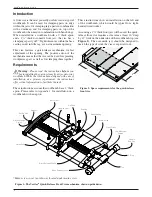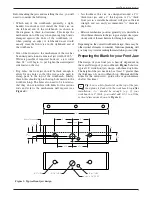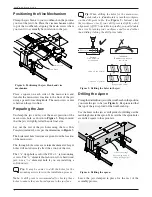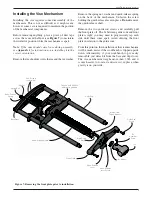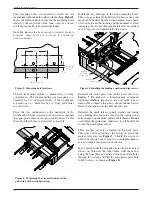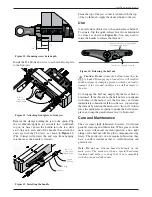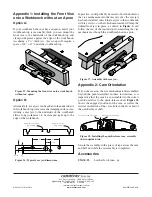
1
1
/
4
"
2
1
/
8
"
Figure 11: Mounting screw hole depth.
Install the #14 fl at-head screws to secure the front plate
to the front jaw.
#14 × 2
"
Flat-Head
Wood Screws
Figure 12: Attaching front plate to front jaw.
Remove the clamps holding the jaw to the apron. Flip
the workbench upright (or reinstall the workbench
top on its base). Insert the handle into the tee, slide
an O-ring onto each end of the handle, then attach the
end caps with the #8 screws, as shown in
Figure 13
.
(The O-rings will protect the end caps from banging
into the tee as the handle is rotated.)
#8 × 1
1
/
2
"
Flat-Head
Wood Screw
Handle
End Cap
O-Ring
Handle
Figure 13: Installing the handle.
Plane the top of the jaw so that it is fl ush with the top
of the workbench. Apply the desired fi nish to the jaw.
Use
A novel feature of this vise is the quick-release half nut.
To actuate, fl ip the quick-release lever from horizontal
to vertical, as shown in
Figure 14
. (You may need to
rotate the handle to release the threads.)
Cam lever in engaged position.
Rotate cam lever to "up" position
to release main screw.
Figure 14: Releasing the half nut.
Caution: Do not
release the half nut when the vise
is loaded. Disengaging a loaded vise will result in
sudden release of clamping pressure, which can lead to
damage of the vise and workpiece, as well as injury to
the user.
To re-engage the half nut, simply fl ip the lever back to
horizontal. If the threads in the half nut are not aligned
with those on the main screw, the lever may not return
immediately to horizontal. If this is the case, you can align
the threads by rotating the main screw; this will, in turn,
force the quick-release spring to nudge the half nut into
place, and snap the quick-release lever to horizontal.
Care and Maintenance
The vise comes fully lubricated; however, it will need
periodic cleaning and lubrication. White grease on the
main screw will ensure smooth operation, and a light
oiling of the half nut will keep this component moving
freely. The guide rods do not require lubrication; they
have a surface treatment that is self-lubricating and
prevents rust.
Note:
Do not
use silicone-based lubricants on the
main screw. The main screw has a special hardening
treatment and surface coating that is not compatible
with silicone-based lubricants.
7
Veritas
®
Quick-Release Front Vise


